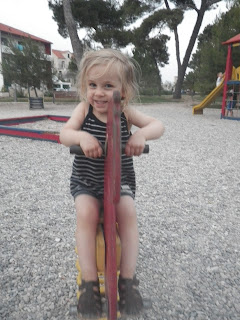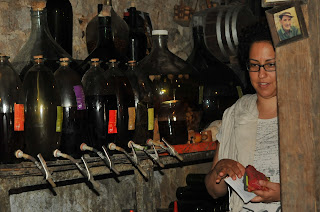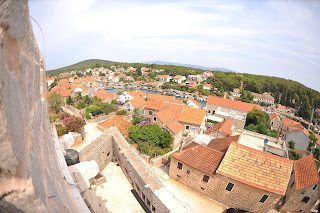Considering it was Terri and Tom's first time to Hvar, we did do SOME tourist stuff- not just ALL swimming- and we always enjoy going to the towns of Vrboska and Stari Grad. Naomi and I discussed how she always gets the two mixed up and I thought, "how strange" then immediately realized that I do too... so I'm not quite sure if I got the photos in the right spots, but here's an attempt:
Vrboska- a sweet, quiet little village with a fantastic little fishing museum which I think we've gone to three times, each time learning something new. THIS time the guy who runs the museum took us to a nearby cellar filled with various types of alcohol and proceeded to give Ana a variety of bottles to take home. Most were liquers (herbal, fig, etc) meant to aide in digestion. We went to a church with a reputedly Titian-school painting but it ended up being painted after Titian's death (but by a follower of Titian). Anyway, we loved it. :-)

 |
| Swimming break after Vrboska and before Stari Grad |
Stari Grad is a town on the northern side of the island of Hvar in Croatia. One of the oldest towns in Europe. Some say THE oldest. ("Stari" translates as "old" and "grad" as "city" in Croatian.) The area around present day Stari Grad was settled by the neolithic tribes of the Hvar culture who occupied the island between 3500 and 2500 BC, and who traded with other settlements around the Mediterranean.
In 219 BC, the Romans defeated the Greek army at Faros, and the town became autonomous under the Roman Empire. The first church was built in the 5th century, in the southeast corner of the town, close to the city walls, on the foundations of a prior Greek house. In the 6th century, a new church was built on the same site, a twin basilica with a baptistry dedicated to St Mary and St John.
Roman Faria was taken over by the Slavs at the beginning of the 8th century. At this point, the town received the name we know it by today - Hvar. In 1278, the people of Hvar chose to put themselves under the protection of the Venetian Republic. As part of the contract, they undertook to expand the town on the south of the island, as a more suitable base for the Venetian fleet. This is the site of the present day town of Hvar. The old town of Stari Grad, also referred to as “Old Hvar”, remained the centre of the most densely populated part of the island, the area surrounding the agricultural plain.
During the 16th century, the town was attacked by the Turks, the first time repulsing them, but in 1571 they lost, and much of the town was burnt down. Following that loss, Stari Grad was slowly rebuilt from the ruins. During the 17th and 18th centuries, prosperity once again grew from sea-trade.
 |
| On the top of the church/ fortress of Stari Grad. |
 |
| The view from the church. |
 |
| The oldest town in Europe also has a great park! |
 |
| Oops- watching Nadja knock something over in a church :-) |














































No comments:
Post a Comment